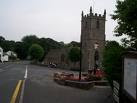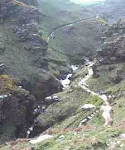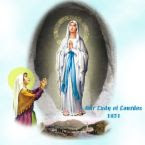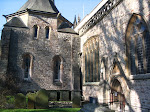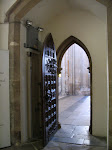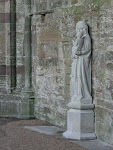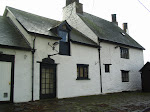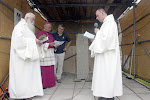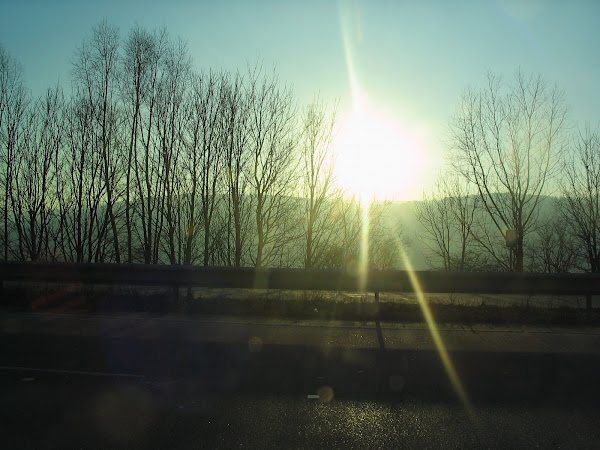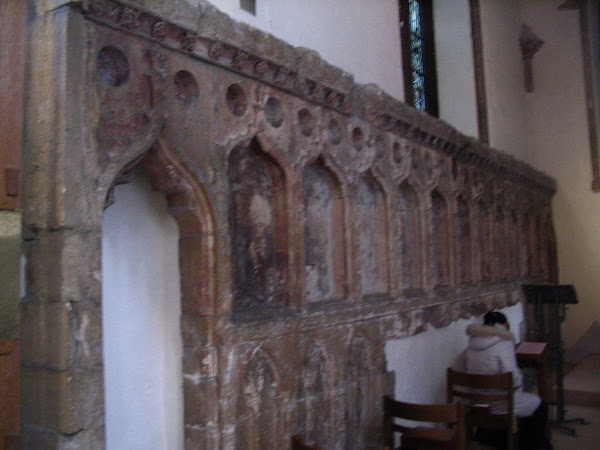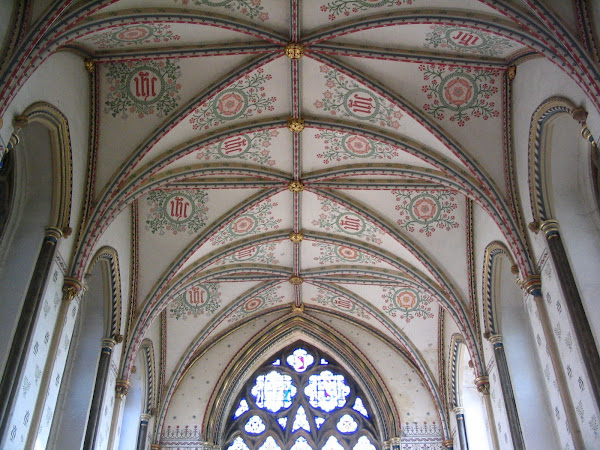








On Fiday I went to visit the little restored Church of Michaelstone y Fedw near Castleton east of Cardiff.Little is known about the early history of this very ancient Church but we do have sources for its founders. St Michael is of course the powerful Archangel of God and slayer of Satan. Legend connects him to the splitting of the Skirryd mountain in the North oF Gwent at the time of the Crucifixion when the veil of the temple was rent in twain. Next Sunday, on Michaelmas, Catholics from Abergavenny will climb the Skirryd to celebrate the Feast day of the powerful Angel .
St Medwy
St Peter sent St Philip, St Joseph of Arimathea, to Northern Europe to spread the gospel of Jesus directly after the events at the Upper House. St Joseph had accompanied the Emperor Vespasian to Britain to trade for tin, so Joseph sailed to Britain, we are told, landed in Wales, possibly at the Roman fort of Caerleon (the principal port in South Wales or Cambria) Archiviragus, brother of Caractacus gave Joseph Land at Glastonbuty (The West of England was called East Wales in those days) and the family were granted land in Garth Madrun (now Talgarth in Breconshire) Jewish names are recorded in the Welsh annals at this time. Remember this was also the family of the Virgin Mary.
King Lucius(great grandson of Caractacus)-and Pope Elutherius
King Lucius British name is Llewrug Mawr. Mawr or the great luminary (hence his latinised name of Lux or Lucius).
Nickname is ‘Lleiver.’
St. Joseph's little circle of twelve disciples was kept going by anchorites – as one died another was appointed; but in course of time a certain slackness seems to have come over them. William of Malmesbury tells us that the holy spot at length became a covert of wild beasts.
He increased the Light that the first missionaries, the disciples of Christ, had brought, by sending emissaries to Eleutherius, Bishop of Rome, requesting him to send missionaries to Britain.
The Pope and the Welsh Saints
The Welsh Triads tell us that Pope Eleutherius, in response, sent St Dyfan and St Fagan, St Medwy and St Elfan, all of them British names, in AD 167.
Gildas, Liber Pontificalis,Venerable Bede
Geoffrey of Monmouth tells us that Gildas (AD 516-570) recorded the names and acts of these missionaries in a book now lost, The Victory of Aurelius Ambrosius.
The story appears again in the second revision of the Liber Pontificalis about AD 685.
The Venerable Bede,
The Venerable Bede, 673-735AD, tells the story of Lucius's appeal to Eleutherius.
Archbishop Ussher
Archbishop Ussher in his De Brittanicarum Ecclesiarum Primordiis (pp. 49-50) tell us that Medwy and Elfan were Britons who were sent as emissaries by Good King Lucius and returned with the missionaries Dyfan and Fagan.
The Monk Saints arrive at Glastonbury before they begin their ministries, Elan and Ffagan to Wales and Dyfan to the site of St Peters, Cornhill in London.Williams of Malmesbury's account ( a monk at Glastonbury Abbey, who knew its traditions)
It is noticeable that the pedigree of Dyfan, as given in the Cambrian Biography, makes him a Briton. The pedigree may be spurious, or he may have been a Briton resident in Rome. William of Malmesbury calls them Fagan and Deruvian, and Geoffrey of Monmouth Faganus and Duvanus. These missionaries journeyed through Britain and came to Glastonbury.




 ______________________________________________________
______________________________________________________The Four Saints arrive at Glastonbury
There, God leading them (wrote William of Malmesbury),
“ they found an old church built, as 'twas said, by the hands of Christ's disciples, and prepared by God Himself for the salvation of souls, which Church the Heavenly Builder Himself showed to be consecrated by many miraculous deeds, and many Mysteries of healing.... And they afterwards pondered the Heavenly message that the Lord had specially chosen this spot before all the rest of Britain as the place where His Mother's name might be invoked. They also found the whole story in ancient writings, how the Holy Apostles, having been scattered throughout the world, St. Philip coming into France with a host of disciples sent twelve of them into Britain to preach, and that there, taught by revelation they constructed the said chapel which the Son of God afterwards dedicated to the honour of His Mother; and, that to these same twelve, three kings, pagan though they were, gave twelve portions of land for their sustenance. Moreover, they found a written record of their doings, and on that account they loved this spot above all others, and they also, in memory of the first twelve, chose twelve of their own, and made them live on the island with the approval of King Lucius. These twelve thereafter abode there in divers spots as anchorites - in the same spots, indeed, which the first twelve inhabited Yet they used to meet together continuously in the Old Church in order to celebrate Divine worship more devoutly; just as the three pagan kings had long ago granted the said island with its surroundings to the twelve former disciples of Christ, so the said Phagan and Deruvian (Dyfan) obtained it from King Lucius for these their twelve companions and for others to follow thereafter. And thus, many succeeding these, but always twelve in number, abode in the said island during many years up to the coming of St. Patrick, the apostle of the Irish.
Traditionally their monastery was on the site of the Chalice Well.



 __________________________________________________________________________
__________________________________________________________________________The site at Michaelstone-y-Fedw
Interestingly the Church of King Lucius, King oif he Silures lies nearby at St Mellons. If you go up to the Sanctuary area of this church and look to the left of the North wall, you can see filled in Roman arches. Two of these are Roman and probably date back to the fourth century, so we know a building stood here in Roman times.The Roman Road from Caerleon to Pembrokeshire was called the 'VIA LUCIA'the way of Light and interestingly also connected with Lucius.The Via Lucia ran within half a mile of Michaelstone and so either there was some kind of military post here, or a very early stone chapel built by St Medwy.
St Medwy was consecrated as a Doctor priest and perhaps this formed the core of his work. Maybe he ministered to the Roman Soldiers and people all around and was welcome on this account.The Reverend John Dale who wrote an excellent guide to the church, writes that very few churches were dedicated to St Michael before 495AD so the first Catholic presence in this spot was given by St Medwy right back in the third century, in full communion with the tradition of the Catholic Church in Rome.
Revd Dale writes:
'We cannot be certain but it is not impossible that hristian worship has been practised here for nearly two thousand years , whih would account for the sense of holiness and calm that everyone perceives on entering the building."
A picture of St Medwy is drawn on plaster next to the window in the North Wall. Experts ave said this is a picture of him and it ressembles others in Europe dating back to the 5th Century AD.
The Original Altar
The altar was consevrated by the Bishop of Llandaff in the 14th century and annointed in consecrated stone. In trying to destroy the relics in these stone altars during the tome when people wrecked these things, we are told it lay cracked on the floor of the chancel for many years and was only restored when the East Window was installed.
The Stained Glass WEast Window
This is a glorious 19th century (Church is now (Anglican) window depticting warrior saints (in comon with Roman Army, St Maurice, St Thomas, St Gerson and St Barbara, the patron saint of artillerymen. The window was donated by Mrs Kemys Tate Tynte in memory of her husband Colonel Charles Kemys Tate. Above, St Cecilia and St Agatha and the main depiction is of the Ascension.
The Rood Loft and Screen
The rood loft and screen was removed in 'Reformation' times and now only the steps leading up to it still remain.
The Tynte Chapel
This is called the Tynte Chapel now, but probably earlier the Kemys Chapel. This was built in the 14th century by Sir Nicholas Kemys who lived in Cefn Mably, a grand house nearby, which interestingly also had a priests Hole! The first Norman ruler of the area had a daughter called Mabel.Under the floor is a vault containing the odies of the members of the Kemys Family. Most of the bodies were wrapped in lead following the human form. Reverend Dales says they must have been very tall men, because one has a sort of hat box on top and this was the truncated body of St Nicholas who defended Chepstow Castle againt the Roundheads and was killed or beheaded(?) after the fall of the castle to the Roundheads in 1648.
His son, who held Pembroke castle in the same year, has a plaque in the vault. The family periodically open the vault to the public so that people did not forget their sacrifice.

 ____________________________________________________________________________
____________________________________________________________________________Pews
High pews were were installed in the church after a great fire in the church in the fifteenth century. After this a vestrey was built outside the North wall of the chapel.
The Font and the Old Oak Table
The Font dates to 16th or 17th Century. The stem is Flemish design .The serpent is probably as suggested by Reverend Dale, the emblem of the Greek god of Medicine, but also the serpent was a Celtic symbol for Christ in the Book of Kells-i.e. the snake shedding its skin as we shed off the skin of the world to become renewed in Christ.
Restoration
the church was restored between 1998 and 2005 with the nave roof and its gold bosses being beutifully restored, a new heating and lighting system , renovated organ , bells refurbished and made to ring 'full circle' A modern toilet and kitchen have also been built in the tower.
Elizabeth Mackie Hess
The tombstone on the right as you leave the porch is inscribed with the name of Elizabeth Hess, first wife of Carl Hess, whose son by his second marriage was the Nazi Party's Deputy Leader Rudolf Hess.
Please visit this agnificent church . Junction 28 of the M4 to St Mellons and then right just after Castleton (signposted) It is open regularly and the key can be obained in the next door Cefn Mably Inn.




















